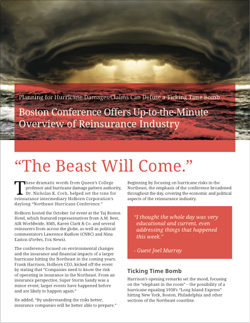“The Beast Will Come.”
These dramatic words from Queen’s College professor and hurricane damage pattern authority, Dr. Nicholas K. Coch, helped set the tone for reinsurance intermediary Holborn Corporation’s daylong “Northeast Hurricane Conference.”
Holborn hosted the October 1st event at the Taj Boston Hotel, which featured representatives from A.M. Best, AIR Worldwide, RMS, Karen Clark & Co. and several reinsurers from across the globe, as well as political commentators Lawrence Kudlow (CNBC) and Nina Easton (Forbes, Fox News).
The conference focused on environmental changes and the insurance and financial impacts of a larger hurricane hitting the Northeast in the coming years. Frank Harrison, Holborn CEO, kicked off the event by stating that “Companies need to know the risk of operating in insurance in the Northeast. From an insurance perspective, Super Storm Sandy was a minor event; larger events have happened before and are likely to happen again.”
He added, “By understanding the risks better, insurance companies will be better able to prepare.”
Beginning by focusing on hurricane risks in the Northeast, the emphasis of the conference broadened throughout the day, covering the economic and political aspects of the reinsurance industry.
Ticking Time Bomb
Harrison’s opening remarks set the mood, focusing on the “elephant in the room” – the possibility of a hurricane equaling 1938’s “Long Island Express” hitting New York, Boston, Philadelphia and other sections of the Northeast coastline.
– Guest Joel Murray
The dense population, high property values and geographical factors—including numerous harbors and a tremendous amount of exposed coastline—all compound the risk of high losses, he stressed. In his address, Dr. Coch added that it’s a case of “when, not if” another major hurricane will hit the Northeast. “Due to the unique makeup of the Northeast, a Category 2 hurricane could produce as much or even greater damage than a Category 4 or even a Category 5 in the South,” he emphasized.
However, looking forward, 2012’s Hurricane Sandy may have paved the way to better, more precise models. In a presentation titled “Modeling Northeast Hurricane Risk,” Risk Management Solution’s (RMS) Michael Young emphasized that Sandy and its aftermath exposed a number of gaps in data capture, which many insurers are now filling. “The high-value content in basements within (New York’s) central business district took many by surprise,” Young said. “In some ways, the hurricane also helped the industry gain a better, more accurate understanding of the storm surge risk landscape.”
What’s the Future of Reinsurance?
Dowling & Company Securities’ VJ Dowling addressed reinsurance from an investor’s perspective. “The capital markets have discovered reinsurance as an asset class because it is a non-correlated risk. The new money is long-term and it is not going away,” he said. “The one thing that could stop [it] is if there is a large, un-modeled loss.”
John Berger, CEO of Third Point, added, “I think alternative capital is here to stay. It’s evolving and is going to change our business.”
Insurance ratings agency A.M. Best also expressed concern, having changed its outlook for the reinsurance market to “negative” in August. “It’s going to be difficult to maintain double-digit returns and high single-digit returns will become more the norm” in the coming years, said Best’s Duncan McColl, adding, “A mega-catastrophic event is the single biggest ‘knock-out’ risk to the reinsurance industry.”
Adam Manus, SVP at Holborn, stressed that while a recent influx of capital (including hedge funds and pension funds) into the reinsurance market has many positive aspects, the trust developed through long-term relationships remains essential to the reinsurance industry’s health.
Far more than investment dollars, long-term relationships will help insurance companies and clients survive in the aftermath of a colossal hurricane and trade well into the future, Manus added.
Knowledge + Preparation = Power
– Frank Harrison, CEO, Holborn
Feedback for the conference—the first in a series of regional meetings addressing climate-based risks to different areas of the country—was highly encouraging. “I thought the whole day was very educational and current, even addressing things that happened this week,” said guest Joel Murray, VP at Norfolk & Dedham Group.
Harrison summarized the message echoed by most of the day’s speakers. “The positive takeaway is that when a truly big disaster comes, the reinsurance industry understands the risks. With the long-term relationships we’ve developed, we will get through a large natural disaster.”
About Holborn
Holborn Corporation is an independent reinsurance brokerage firm which was founded in 1920 and is headquartered in New York City. Through the adoption of an Employee Stock Ownership Plan (ESOP) during 1998, it became exclusively owned by its employees. For additional information, please visit the Holborn website at www.holborn.com.


